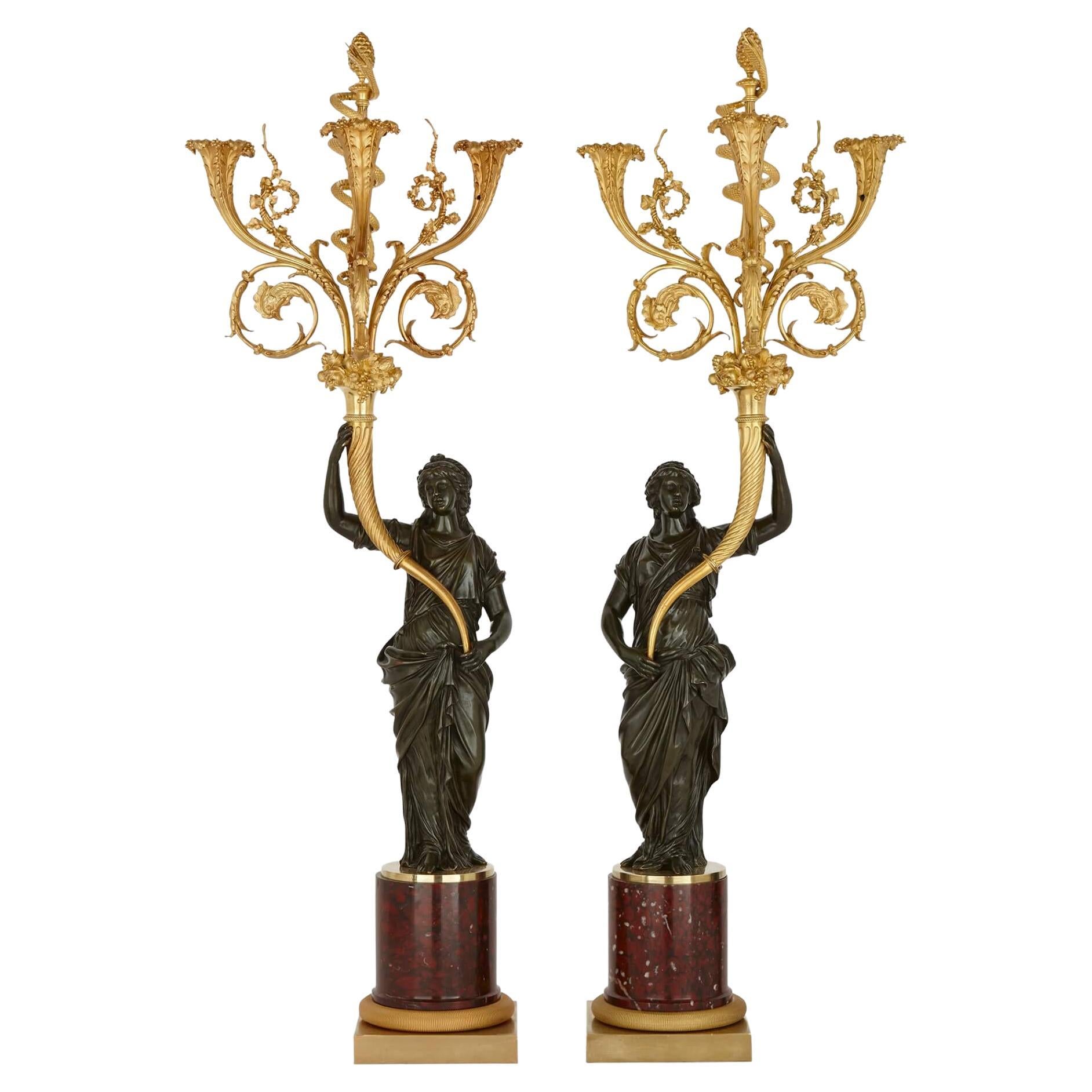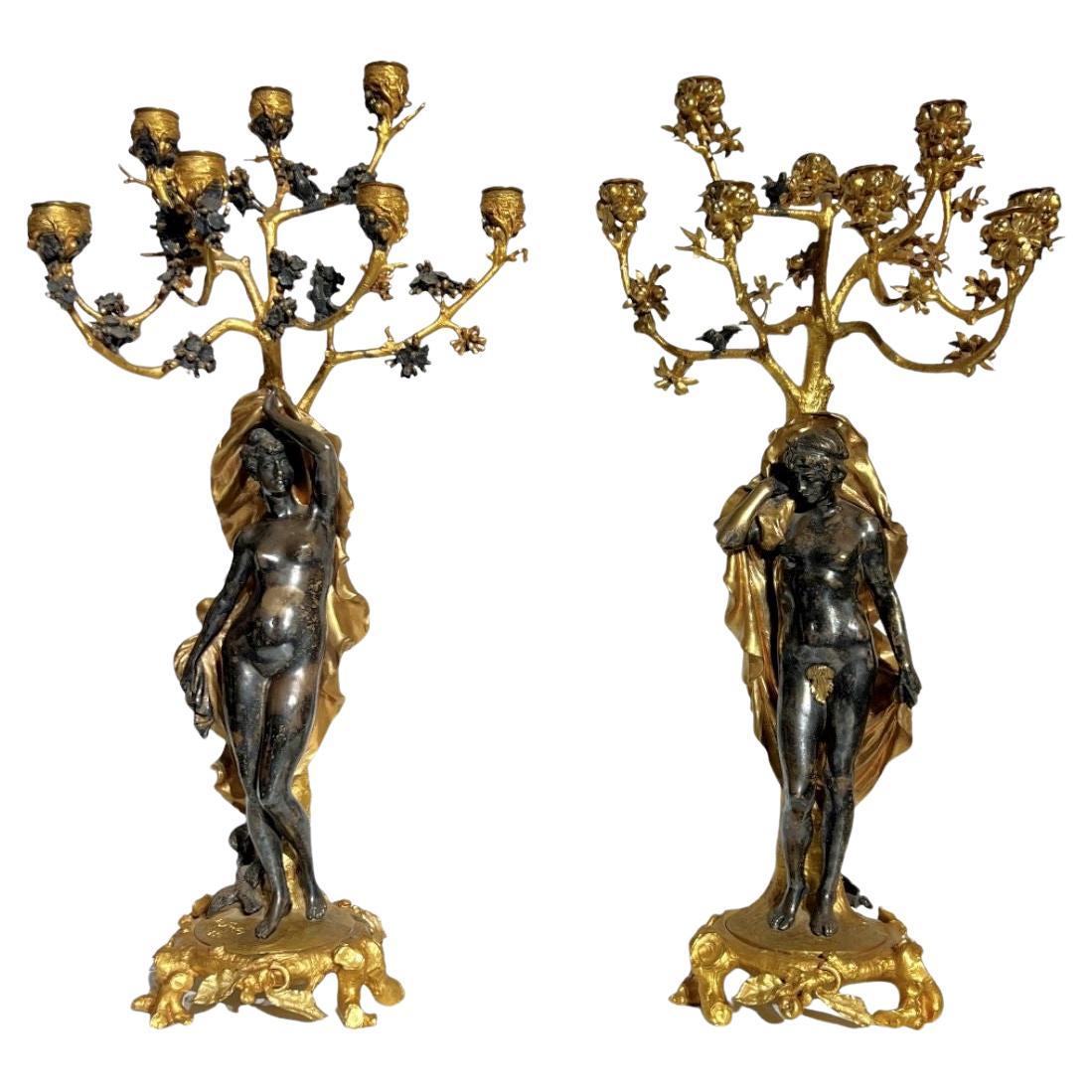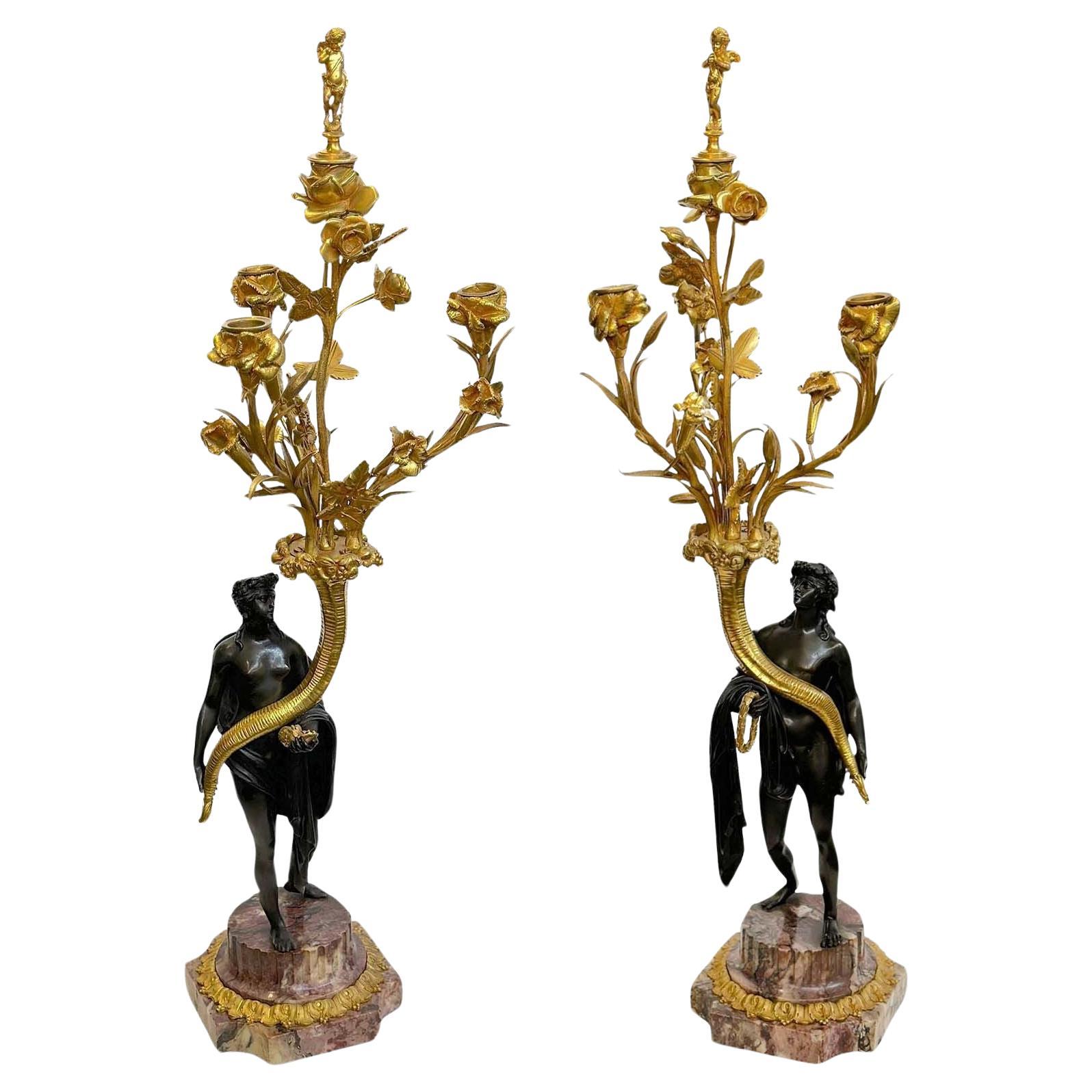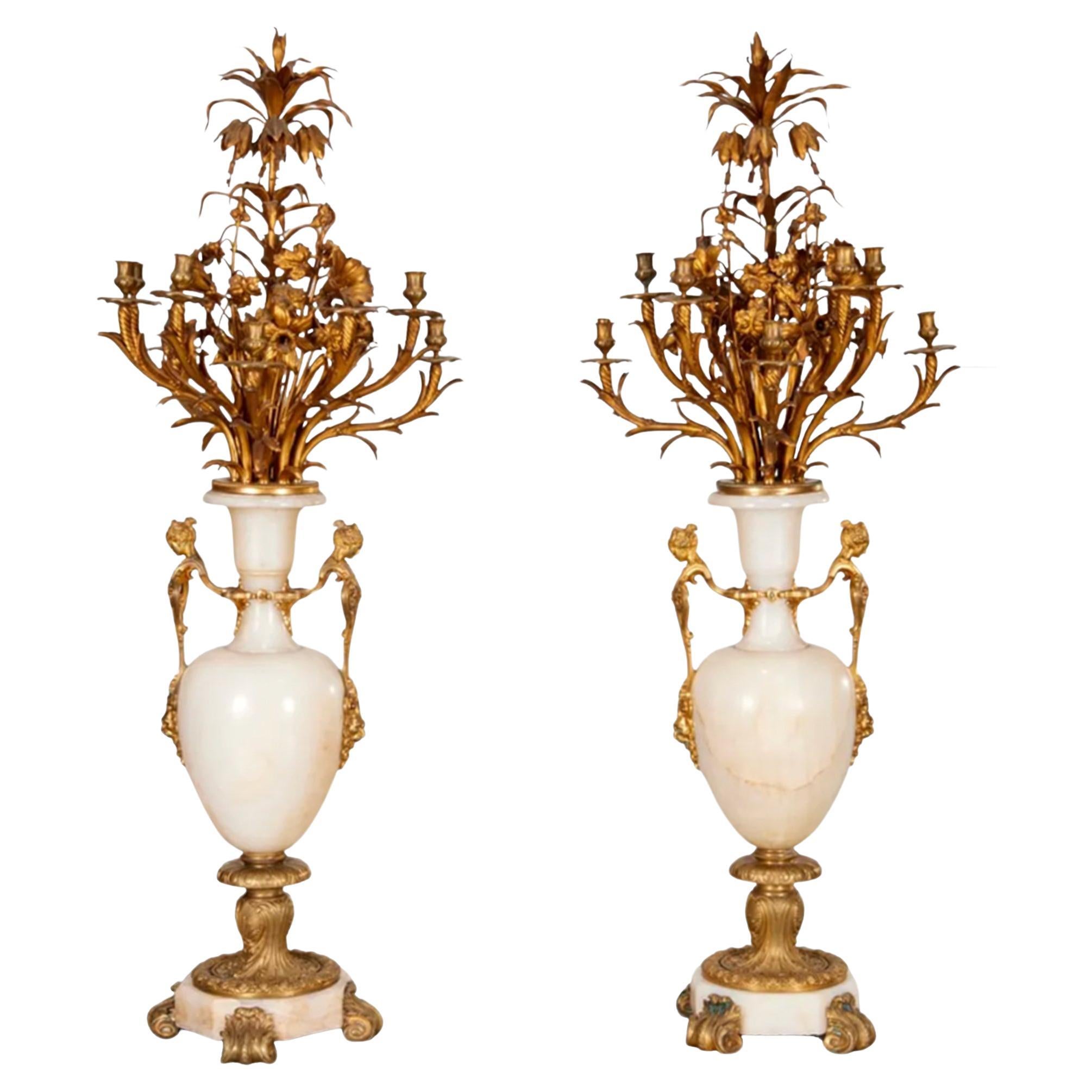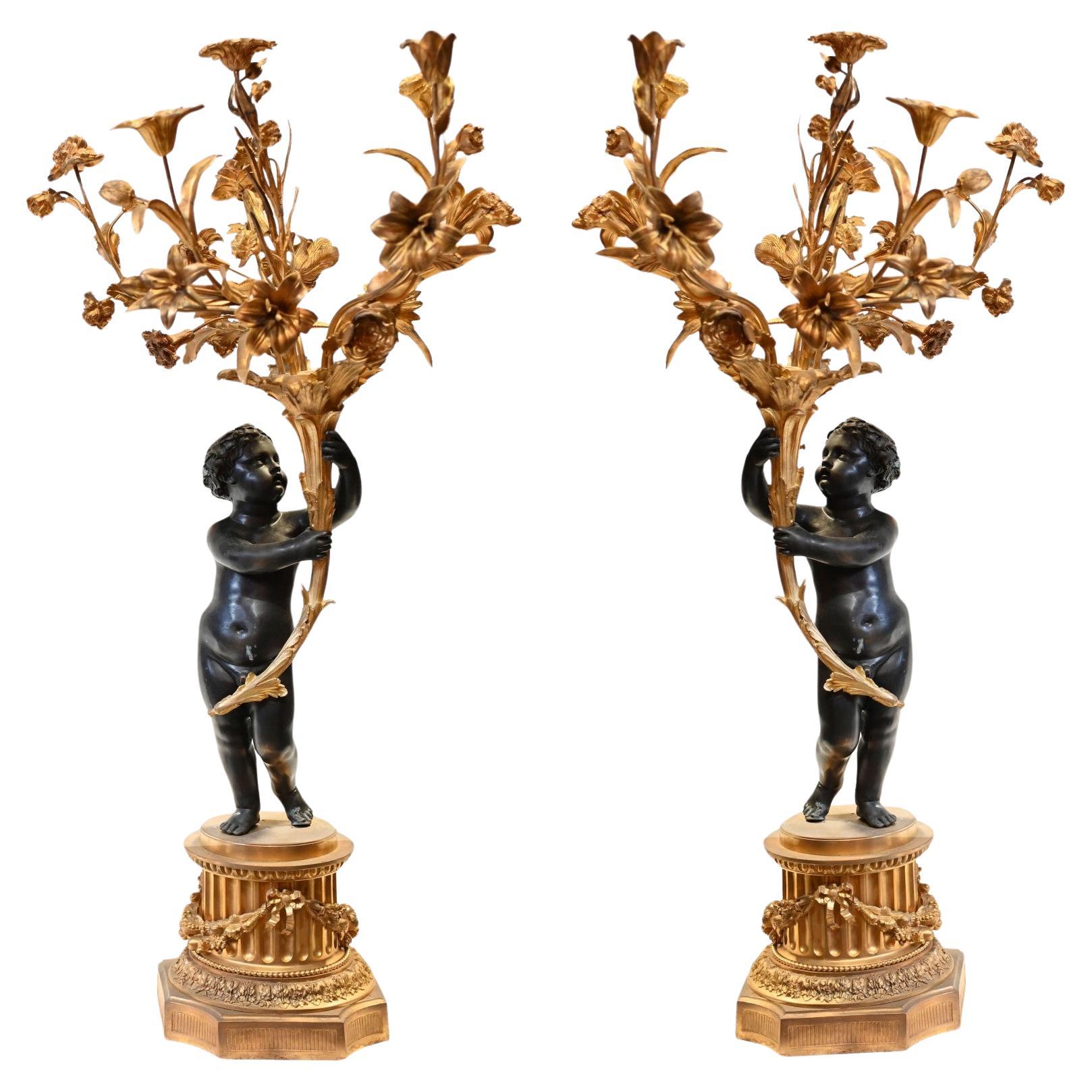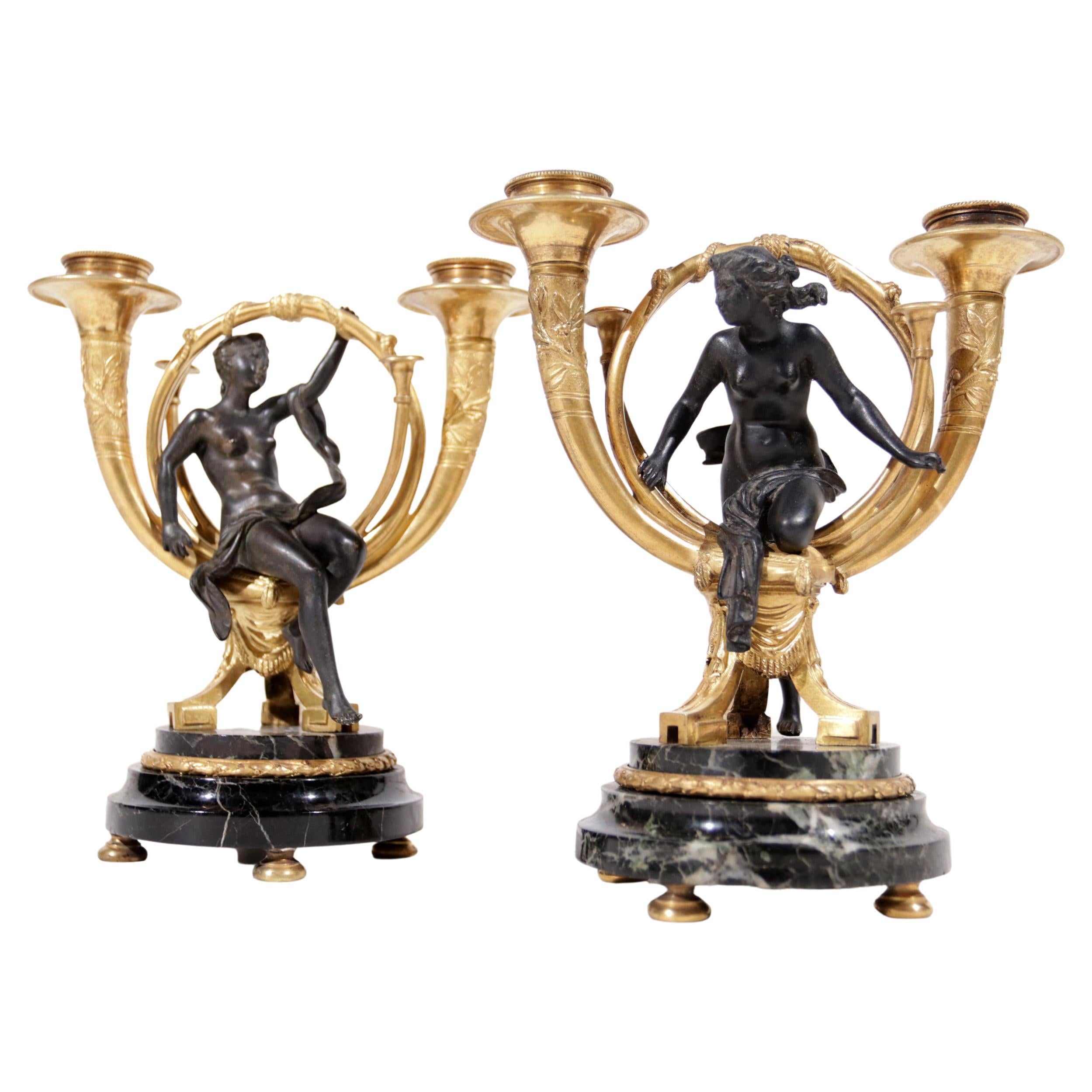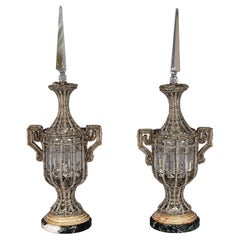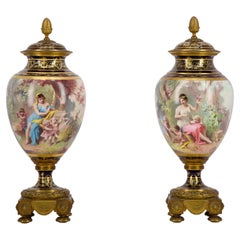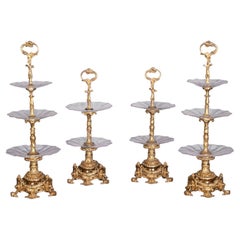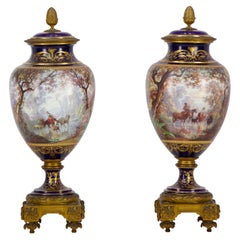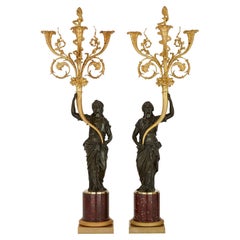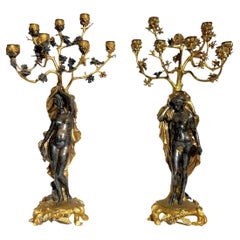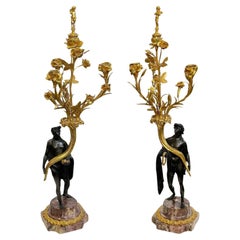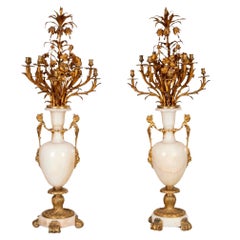Items Similar to Pair of candelabrum with 9 lights in gilded, silvered and burnished bronze
Want more images or videos?
Request additional images or videos from the seller
1 of 21
Pair of candelabrum with 9 lights in gilded, silvered and burnished bronze
$336,572.64
£250,017.27
€281,250
CA$464,325.52
A$510,421.50
CHF 268,254.12
MX$6,198,375.98
NOK 3,346,402.79
SEK 3,170,481.32
DKK 2,141,020.71
About the Item
This splendid pair of candelabrum was made by Auguste-Louis Marquis (bronze maker) for the Maison Giroux circa 1855 in gilded, silvered and burnished bronze, the set on a cylindrical stand made of blackened wood resting on a square base.
Reflection of the eclecticism from the second half of the 19th century, our pair of candelarbum illustrates the exuberance of the Napoleon III style and the classicism of the Louis XVI style. The bronze maker has represented here the theme of the silent children, through winged putti with one finger put on their mouth, in burnished bronze. From their free hands, they hold a gilt bronze quiver where is resting a roses bouquet below large lily flowers being shaped to be light arms and of which the flowers are lightened up with a beautiful silver work. The putti are lightly dressed with a drapery hold by a strap roses garland and are bearing a crown of this same flower in their hair. About the cylindrical stand made of blackened wood, it is very typical of the Louis XVI style with its gilded bronze decoration of flowers garlands and laurel leaves flowers on which they stand.
We find on a sketching book indexing the works made by the maison Giroux, conserved in the Musée des Arts Décoratifs of Paris, a drawing depicting one of our candelabra, allowing us to confirm that they were sold by the maison created by Alphonse Giroux in the late 1790’s.
This store which was originally selling all kind of supplies and small objects such as paints, varnishes, albums, writing-papers, fans, toys, boxes and souvenirs, but also lithographs, drawings and watercolors, considerably developed in the first decades of the 19th century. First, because they count among the clients, important persons such as the Duchesse de Berry, Louis XVIII or even Charles X, then by the drive given by Alphonse Giroux’s sons who joined the firm in 1833. Thus, Alphonse-Gustave Giroux, the eldest son, had the idea to sell small furniture. Even though he was an artist himself, he worked like furniture dealers of the 18th century, with artists who did not have the right to put their signature and exerted a hold over the design of the creation that he chose. He also decided to move the store in the new Opera district on the corner of the 43 boulevard des Capucines and the 24 rue Neuve des Capucines in 1855.
On this same year, the company which had already won medals for the quality of its production during previous events, sells during the World Fair, to the Impress Eugénie, a bonheur du jour, conserved today in the château de Compiègne. In 1867, the store direction is given to Ferdinand Duvinage, Harinkouck and Brune. Little things are known about Harinkouck and Brune who seem to have been associated for a short period of time as Duvinage remains the only one in 1874.
A similar pair, a little bit smaller, with only 7 light arms, and made entirely of gilded bronze is illustrated on Marie-France Dupuy-Bellet’s book: Les bronzes du mobilier national 1800-1870, on the page 303.
The handwritten documentation of the Mobilier national allows to name their author: Auguste-Louis Marquis, who delivered them to the Garde-Meuble in April 1855 for the Palais Royal. They are next send, 22 years later to the Palais de l’Élysée where their presence is mentioned in the Ladies Salon in 1894.
The maison Chaumont and Marquis, founded in 1731, made and sold bronze, chandeliers, clocks, candelabrum, etc. They participated during the World Fairs of 1862 and 1867.
Thus, as written above, it seems that Alphonse Giroux asked Auguste Marquis to make a model of candelabrum from his original one, while imposing his modifications that we can notice by comparing the formal differences between the two pair of candelabrum. This manner to ask other artists to create models is really usual for the important companies selling art in the late 19th century. We can also mentionned l'Escalier de Cristal which worked with Gabriel Viardot, Emile Gallé and others, or Edouard Lièvre who worked for the maison Barbedienne.
Bibliography :
Marie-France Dupuy-Bellet, L’heure, le feu, la lumière, Les bronzes du mobilier National 1800-1870, Editions Faton, 2005
- Dimensions:Height: 91.34 in (232 cm)Width: 22.84 in (58 cm)Depth: 28.35 in (72 cm)
- Style:Napoleon III (In the Style Of)
- Materials and Techniques:
- Place of Origin:
- Period:
- Date of Manufacture:Circa 1855
- Condition:
- Seller Location:SAINT-OUEN-SUR-SEINE, FR
- Reference Number:Seller: 132001stDibs: LU7662232252852
About the Seller
No Reviews Yet
Recognized Seller
These prestigious sellers are industry leaders and represent the highest echelon for item quality and design.
1stDibs seller since 2022
Typical response time: 10 hours
- ShippingRetrieving quote...Shipping from: SAINT-OUEN-SUR-SEINE, France
- Return Policy
Authenticity Guarantee
In the unlikely event there’s an issue with an item’s authenticity, contact us within 1 year for a full refund. DetailsMoney-Back Guarantee
If your item is not as described, is damaged in transit, or does not arrive, contact us within 7 days for a full refund. Details24-Hour Cancellation
You have a 24-hour grace period in which to reconsider your purchase, with no questions asked.Vetted Professional Sellers
Our world-class sellers must adhere to strict standards for service and quality, maintaining the integrity of our listings.Price-Match Guarantee
If you find that a seller listed the same item for a lower price elsewhere, we’ll match it.Trusted Global Delivery
Our best-in-class carrier network provides specialized shipping options worldwide, including custom delivery.More From This Seller
View AllPair of Antique Crystal Lamps
Located in SAINT-OUEN-SUR-SEINE, FR
This beautiful pair of lamps was made of crystal in the late 19th century, early 20th
The lamps are composed of crystal pendants of different shapes and sizes attached together by i...
Category
Early 20th Century French Belle Époque Table Lamps
Materials
Crystal, Marble
Pair of porcelain vases mounted in gilt bronze, circa 1890
By Manufacture Nationale de Sèvres, Charles Labarre
Located in SAINT-OUEN-SUR-SEINE, FR
This very beautiful pair of ovoid and covered vases was made of Sèvres porcelaine and mounted in gilt bronze. The two vases depicts a painted decor b...
Category
Antique 19th Century French Napoleon III Vases
Materials
Bronze
Centre de table de style Napoléon III en bronze doré et cristal taillé, vers 185
Located in SAINT-OUEN-SUR-SEINE, FR
Ancienne collection du château de Dampierre
Important centre de table composé de quatre pièces en bronze doré finement ciselé et cristal taillé, de style Napoléon III. Deux pièces s...
Category
Antique 1850s Napoleon III Serving Pieces
Materials
Crystal, Bronze
Pair of Sèvres porcelain vases mounted in gilt bronze painted by J. Machereau
By Manufacture Nationale de Sèvres, Charles Labarre
Located in SAINT-OUEN-SUR-SEINE, FR
This beautiful pair of covered vases made of porcelain originally comes from the Manufacture of Sèvres where the white pieces were bought in 1869, decorated then mounted in gilt bron...
Category
Antique 19th Century French Napoleon III Vases
Materials
Bronze
Bronze Gilded Suspension with Glass Gemstones, Napoleon III Period
Located in SAINT-OUEN-SUR-SEINE, FR
This gilt bronze chandelier has eight branches which take the form of glassware and candles and surround a semi spherical decorated with glass gemstones. Result of a very careful wor...
Category
Antique 19th Century French Napoleon III Chandeliers and Pendants
Materials
Multi-gemstone, Bronze
Napoleon III Vase in Porcelain of Paris Mounted in Gilt Bronze with Espagnolette
By Manufacture Nationale de Sèvres
Located in SAINT-OUEN-SUR-SEINE, FR
This exceptional monumental vase in porcelain of Paris, conceived in the spirit of the Sèvres Manufactory’s productions, is quite characteristic of the Napoleon III style . The long neck of the shape is extremely rare, as well as the gilt bronzes’ richness of ornamentation. Its dimensions and its important bronze mount indicate a ceremonial piece, of supreme luxury, comparable to those the Manufactory exhibited at the World's Fairs. Evoking the aristocratic art of the Ancien Regime in many ways, this vase pays tribute to the refinements of the 18th century, and could have been commissioned to decorate the mansion of a 19th century personality.
Indeed, the “Celestial blue” background, embellished with gold arabesques, is characteristic of the porcelains from the Royal Manufactory of Vincennes as early as 1753, which became the Sèvres Manufactory. It is a famous blue, difficult to obtain, which served to decorate the first service delivered to Louis XV.
The lively shapes of the bronze base also evoke the art of the ornamentalists in Louis XV’s time, such as Jean-Claude Duplessis or Gouthiere, who were in charge of drawing gilt bronze mounts for China porcelain. The bronze mount of our vase is hence very close to the Duplessis’ ornementations.
The two espagnolettes, with sheathed busts of women...
Category
Antique 19th Century French Napoleon III Vases
Materials
Bronze
You May Also Like
Pair of Large French Bronze and Gilt-Bronze Candelabra
By François Rémond
Located in London, GB
This impressive pair of candelabra features two Classically modelled maidens, holding above their head an extravagant fruit-filled golden array, which each issue a trio of candle-bra...
Category
Antique Late 19th Century French Neoclassical Candelabras
Materials
Bronze, Ormolu
Pair Exceptional 19th Century French Gilt and Silvered Bronze Candelabras
Located in New York, NY
Pair of neoclassical figural candelabra in silvered and gilt bronze designed by the French author, essayist and artist,
Judith Gautier (1845-1917), signed and dated 1886, depicting ...
Category
Antique Late 19th Century French Neoclassical Revival Candelabras
Materials
Bronze
Pair of French 19th Century Gilt Bronze Candelabras with Marble Base
Located in Los Angeles, CA
Pair of Napoleon III patinated and gilt bronze figural candelabras. Each standing on rouge royal marble bases, the figures appear to be gracefully holding a cornocupia full of flower...
Category
Antique Late 19th Century French Candelabras
Materials
Marble, Bronze
Monumental Pair Napoleon III Bronze Candelabras
Located in New York, NY
A monumental pair of antique French Napoleon III bronze and white onyx candelabras, dating back to the late 19th century. In baluster-form with gilt bronze handles formed as female c...
Category
Antique 19th Century French Napoleon III Candelabras
Materials
Onyx, Bronze
Pair Bronze Candelabras - Large French Cherub Manner Clodion
Located in Potters Bar, GB
Gorgeous pair of French Empire style bronze cherub candelabras
Good size to them at three feet - 91 cm - tall
Classic French Empire look, great interiors driven pair
In the manner of...
Category
Vintage 1980s Empire Candelabras
Materials
Bronze
Pair of Exquisite French Empire Gilt Bronze Two-Light Candelabra ca 1810
By Pierre-Philippe Thomire
Located in Boven Leeuwen, NL
These candlesticks are ornate artifacts from the French Empire period, which dates back to the early 19th century, typically considered as the reign of Napoleon I from 1804 to 1814. ...
Category
Antique 1810s French Empire Candelabras
Materials
Gold, Bronze
More Ways To Browse
Mobilier National
Large Late 19th Century French Bronze Chandelier
Toy Box
Escalier De Cristal
Viardot Gabriel
Fan Box
Gilded Bronze Vase
Maison Alphonse Giroux
Ferdinand Duvinage
Czech Blue Vases
Large Ceramic Centerpiece
Modern White Clay Vase
Paolo Venini Art Glass
Post War Modern Furniture
Twist Vase
Vase Blown Glass Mid Century Modernist
Vintage Bitossi
Vintage Drip Glaze Vase
